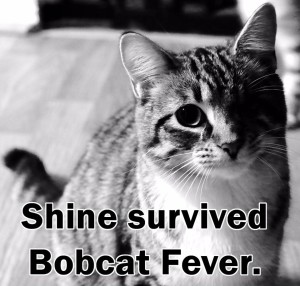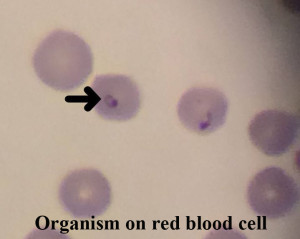Northwest Arkansas has seen great improvement in the treatment and response of the often deadly feline disease known as Bobcat Fever.
I saw my first cat with Bobcat Fever in the late 1990’s as a recent veterinary school graduate. A coworker brought her cat into the clinic for lethargy and decreased appetite. The cat had a fever (usually quite high, >104°) and we started him on antibiotics and hospitalized him. He continued to go downhill and started having difficulty breathing, eventually making a horrible, pained cry. The owners decided to end his suffering and sent the cat’s remains to the state pathology lab for testing. The culprit was a deadly blood parasite, Cytauxzoon felis, or “Bobcat Fever”. This cat had lost his life because of a tick bite. I felt helpless and hoped to never see a case like this again; I would never forget that painful yowl. Unfortunately, it was only the first of many times I would experience this deadly disease.
I learned about “Cytaux” (vet slang, pronounced SIGH-tox) in school and was taught that it was 100% fatal. The poor cat’s suffering really brought that statistic to life for me. I wished I had been able to diagnose sooner, even though in this case the parasite did not show up on microscopic examination of the blood. At that time, I did further research and there were still no recommended treatments available. I did, however, find a reference to a strain of the disease in Northwest Arkansas that some domestic cats could survive. My first glimmer of hope! This was in the Merck Veterinary Manual and is still referenced in the current edition. “A study of C felis in northwestern Arkansas and northeastern Oklahoma indicated survival of natural infection in 18 cats with and without treatment; these cats seemed “less sick” initially, did not have temperatures >106°F (41°C), and never became hypothermic.” (www.merckvetmanual.com) Click to see full article.
Bobcat Fever gets its name because bobcats were thought to be the only true host for the organism. Domestic cats were considered to be a “dead end” host because they died too acutely to pass on the disease. It was thought that a tick must first bite a bobcat in order to infect a domestic cat. Now we know that domestic cats can be carrier hosts too. I suspect that this is why Cytaux seems to be on the rise in Northwest Arkansas. Our growing population means more cats are becoming carriers. I believe the number of cases has truly increased since I started practicing in the area, but increased awareness of the disease has certainly led to increased diagnosis as well.
Unfortunately, drugs like doxycycline that are used to treat other blood parasites have no effect on Cytauxzoon felis. Over the years other treatments came into favor, including Imidocarb injections. We saw one or two survivors, but in hindsight they probably responded more to the supportive care than the injections. (Imidocarb is no longer recommended.)
Finally, around 2008 there was more hope. We were asked to participate in a new drug study from the University of Missouri College of Veterinary Medicine. They sent us a new protocol that we are still using with success today. The protocol is often referred to as “A & A“. It stands for Azithromycin (the antibiotic in Z-paks) and Atovaquone, an anti-protozoal drug used to treat parasitic pneumonia in people. Hospitalization with I.V. fluids, nutritional support, pain management, and drugs to prevent clotting issues and more are usually needed as well.
What are the symptoms?
-Poor or no appetite
-Lethargy
-Breathing hard
-Moderate to severe pain (from internal organs, hard to localize.)
-Symptoms- including high fever and sometimes jaundice (yellow appearance to the eyes, skin and gums.)
-Bloodwork can show signs of red blood cells being destroyed (which leads to jaundice) and other abnormalities.
-Parasite seen on microscopic examination of blood. -Send out for testing at lab (takes too long to get results in most cases.)
What should you do if you suspect Bobcat Fever?
Take your cat to your veterinarian immediately. This is a true emergency and every minute counts.
How to prevent:
-Keep cats indoors, especially during tick season. No tick preventive is 100% effective..
-Keep cats on the best tick control products available. Even indoor cats are at risk. Ticks can be brought in the house by people or other pets. Ask your veterinary hospital which products work best. They will be able to point you towards the safest and most effective products. Only use products that are specifically labeled for cats.
-There is currently no vaccine available.
Cytaux is one of the deadliest cat diseases you can imagine. It kills healthy cats in a matter of a few days. However, cats can survive. Early diagnosis and treatment is critical. Sadly, some cats will not make it, even with aggressive treatment.
Here is an article with great images of the parasite on blood smears. Please note, it is from 2008 and does not include the current treatment. (A&A) Click to see article.
The Animal Emergency Clinic in Springdale is extremely proficient at diagnosing and treating this disease. They have saved many of my patients’ lives. If your regular vet is not open on a night, weekend, or holiday, I highly recommend that clinic.
Veterinary professionals in the Northwest Arkansas area hate the risk this disease poses for our feline patients. Fortunately there have been advances in treatment. Hopefully bringing additional awareness, through such articles and education, will help save the lives of many local cats.
© 2015 Beth Stropes, DVM







